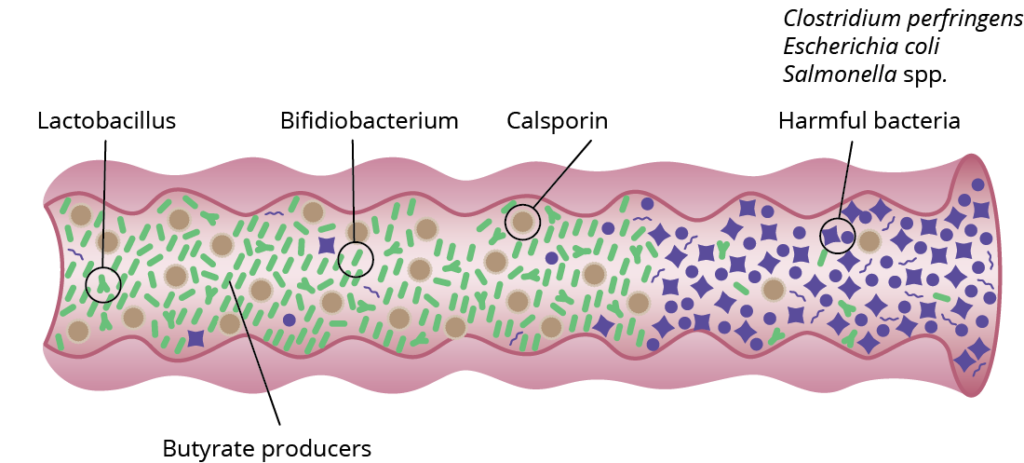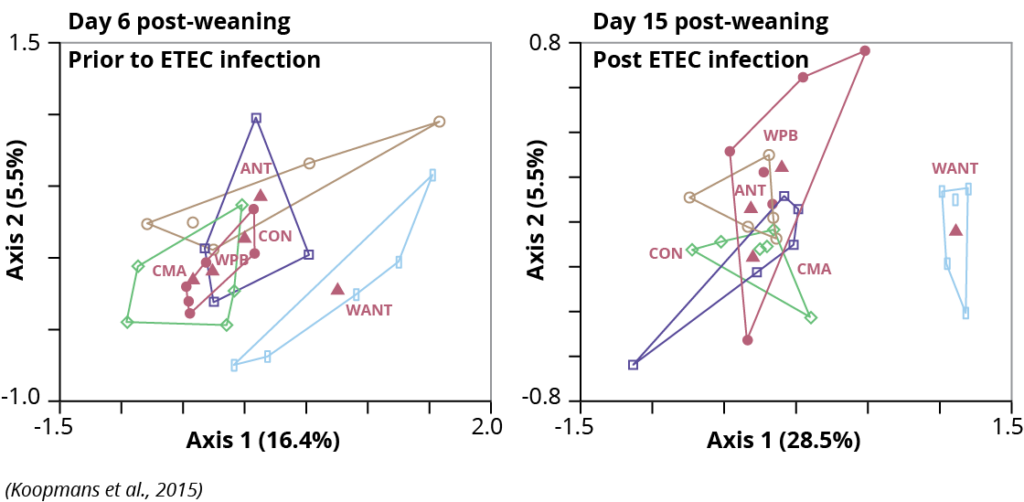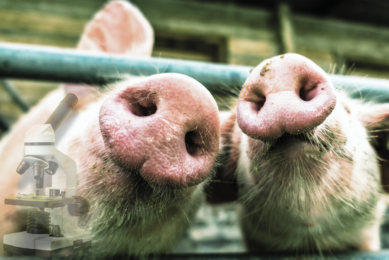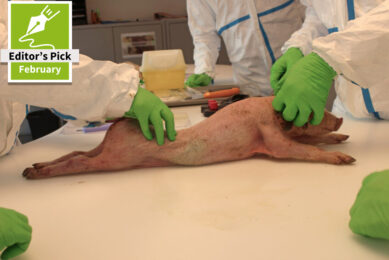Bacillus velezensis: A gut health solution

This article summarises the studies on carried using Calsporin, a probiotic that contains spores of Bacillus velezensis, focusing on its influences on different gut pathogens in poultry and swine.
WORLD OF MICROBES SPECIAL 2024 – read all articles
Animal health and food safety are intrinsically linked to animals’ intestinal conditions and the composition of the microbiota. Gut pathogens can harm the animal itself, and different bacterial species are also associated with food safety and zoonotic disease. Beneficial bacteria, added to the diet as probiotic, are used to reduce potentially harmful bacteria in the digestive tract and improve the microbial balance in the intestine.
Calsporin is a probiotic with a long history, during which extensive experience and knowledge have been gained. The product contains viable spores of Bacillus velezensis DSM 15544, and is known for its wide application in multiple animal species and categories.
Figure 1 – Probiotics support a more diverse microbiota with beneficial microbes.

Control of opportunistic pathogens
Numerous studies with Calsporin in poultry diets resulted in a reduction or even exclusion of the most common pathogens, namely Clostridium perfringens, Campylobacter, Enterococcus cecorum, Escherichia coli, and Salmonella species (Figure 1).
* Salmonella is the most well-known enteric pathogen in poultry. It is primarily associated with contaminated eggs and meat products, which are a significant source of human Salmonella infections. S. Enteritidis and Typhimurium are serovars commonly reported in human salmonellosis cases. Enhancing the birds’ intestinal microbial diversity through the addition of the probiotic Bacillus velezensis, could explain the observed reduction of Salmonella, and more specifically these harmful serovars, in the gut of layers and broilers.
* Another notable challenge in the poultry industry is the prevalence of the foodborne disease relating to Campylobacter. Despite extensive research, the pathogenesis of Campylobacter is complex and not fully understood. Bacillus velezensis DSM 15544 has shown promising results in controlling Campylobacter infections in broiler flocks, as demonstrated in the large European project CAMPYBRO.
* Following coccidiosis infections, Clostridium spp. frequently caused complications resulting in Necrotic Enteritis (NE). The damaged intestinal wall of broilers provides an ideal environment for the development of virulent strains of C. perfringens, causing even more severe lesions characteristic of NE. In practical trials and experimental research using NE models, the addition of Bacillus velezensis DSM 15544 resulted in decreased levels of C. perfringens, reduction of lesion scores and improved gut integrity. This leads to faster recovery of the birds, higher growth performance, lower mortality rates and fewer treatments needed to stabilise gut health.
* Enterococcus cecorum is one of the most common pathogenic bacteria in bacterial chondronecrosis with osteomyelitis (BCO), a costly disease which causes lameness in fast growing broilers. Maintaining gut health is crucial, as these bacteria can gradually permeate the intestinal epithelium, entering the bloodstream and triggering infections. In a university trial, the combination of yeast cell wall (MOS) and Bacillus velezensis DSM 15544 in broiler diets, delayed the onset of BCO and reduced its incidence by half.
Assure gut health of sows, piglets and fatteners
Stabilising the microbiota and promoting competition from beneficial bacteria through the use of probiotics in swine diets, can prevent the overgrowth of opportunistic pathogenic species such as Clostridium, E. coli, Salmonella and Brachyspira.
A well-known strategy involves administering probiotics during the weaning period, when the microbiota is immature and stress factors increase the risk of microbial imbalances. Incorporating Calsporin into piglet diets post-weaning has been shown to enrich the microbiota composition and stimulated the presence of Lactobacillus species and butyrate producers. Following an E.coli (ETEC) challenge, piglets receiving the dietary probiotic exhibited lower faecal shedding of E.coli and reduced incidences of diarrhoea. While antibiotic treatments achieved similar results in controlling ETEC-induced weaning diarrhoea, they negatively impacted the gut microbiota composition. Specifically, antibiotics reduced the abundance of Lactobacillus species, creating an environment more conducive to the development of other pathogenic species (Figure 2).
Figure 2 – Antibiotic treatment after weaning (WANT-group) was effective against ETEC induced weaning diarrhoea, negative impact on the composition of the microbiota. The probiotic treatment after weaning (WPB-group), had a positive effect on both the E.coli infection and stabilisation of the microbiota.

Probiotics remain effective in sows and fattening pigs with a well-established mature microbiota. Trials have shown that sows supplemented with probiotics have increased levels of beneficial Lactobacilli, bifidobacteria, and butyrate producers, while harmful Clostridium clusters and Escherichia bacteria are reduced. The healthy microbiota of the sow is passed on to their newborn piglets, resulting in lower incidence and severity of diarrhoea in suckling piglets.
Calsporin was successfully tested on a farm with chronic swine dysentery infection. After one month of probiotic supplementation, the issues on the farm decreased, leading to a reduction in antibiotic use during the 6-month trial period. At the start of the trial, faecal analyses confirmed the presence of Brachyspira hyodysenteriae. At the end of the trial period, all faecal samples tested negative for B. hyodysenteriae as well as B. pilosicoli.
Probiotics are frequently used on farms with higher incidences of Haemorrhagic Bowel Syndrome (HBS) in sows, growing, and finishing pigs. HBS is characterised by sudden death, without any incidence of diarrhoea or other clinical signs in advance, and is accompanied by pale skin, abdominal distension and intense red colouration of the intestine. Although the causative agent is unknown, with Clostridium often suspected, preventive stabilisation of the microbiota with probiotics shows promising effects and offers relief for farmers.
Probiotics as insurance for gut health
It is crucial that the environment of the intestine is populated with a sufficient numbers of beneficial microbes and maintains good stability. Adding probiotics in the feed serves precisely this purpose, helping to stabilise the gut microbiota.







